Terror in the Tasman: Remembering the 1998 Sydney to Hobart Yacht Race, 20 years on
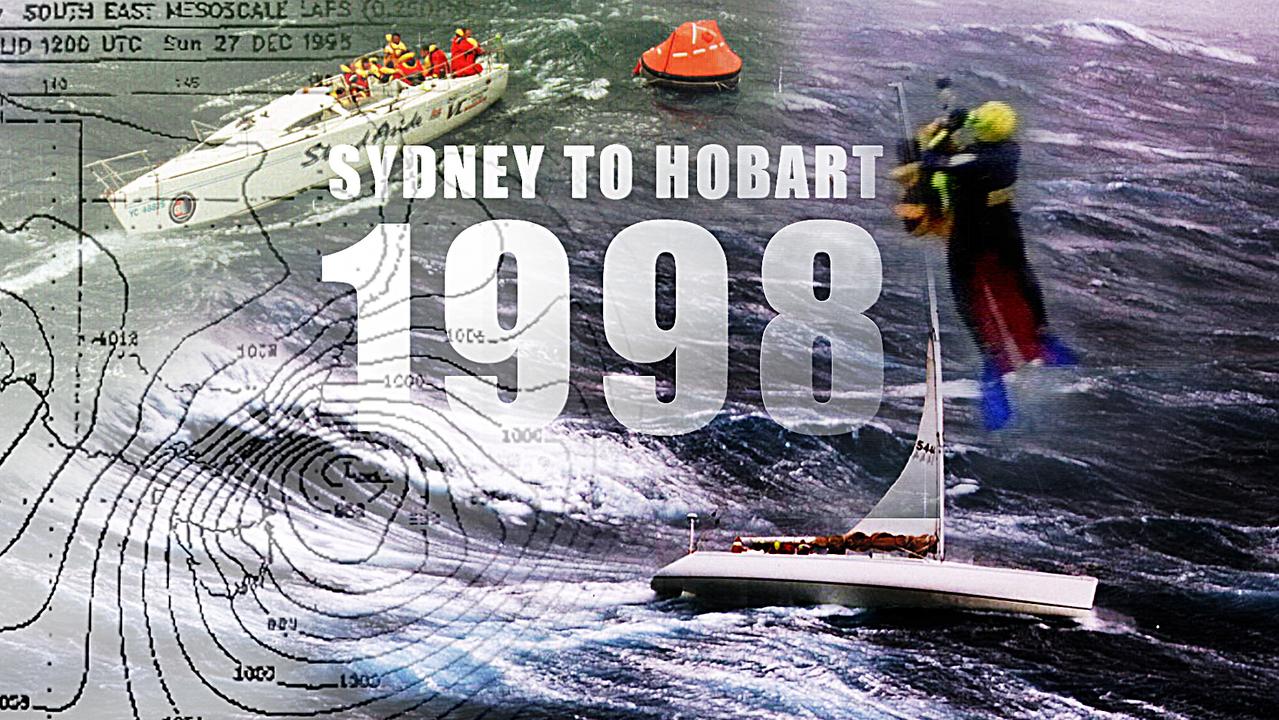
It began, as they all do, at 1pm on Boxing Day in Sydney Harbour.
Just 48 hours later, six lives had been lost in what became the deadliest incident in Australian sailing history.
Less than half of all starters made it to the finish line. Some 24 boats were completely abandoned or written off and 55 sailors had to be rescued, by both aircraft and Royal Australian Navy ships. In all, it was our nation’s biggest ever peacetime rescue operation.
Twenty years on from the 1998 edition of the Sydney to Hobart Yacht Race, Foxsports.com.au looks back at how the terrible tragedy unfolded.
At the starters’ gun, 115 yachts took off through Sydney Harbour and out into the Tasman Sea, to make the 628-nautical mile journey to the south-east of Tasmania.
Yet there were already troubling signs.
A few hours earlier, at the final briefing conducted by the Cruising Yacht Club of Australia, sailors were warned of a low pressure system forming off the coast.
“It’s going to be very hard in Bass Strait, so get ready for a nasty one,” Bob Thomas, navigator and co-owner of AFR Midnight Rambler, told skipper Ed Psaltis in comments reported by Fairfax Media .
Don Buckley, a crew member on B52, spoke to NSW Police a month after the race .
“We had a last-minute update and ... the night before it had been pre-empted that perhaps the low was forming and that would be the only spanner in the works, that we might have some hard stuff,” Buckley said.
“It was hard to know how strong it would be but he (the team’s weather expert) certainly said, ‘you’ll get hammered’.
“Most people expect at some time in the Hobart race you’d have a southerly, and it’s just the cycle of the race. So I guess it didn’t ring any more alarm bells than, OK, it will hit us at some stage.
“We felt comfortable.”
Billionaire tech mogul Larry Ellison, a keen sailor, was skippering the yacht Sayonara, which eventually took line honours. But even he wasn’t expecting to get out as well as they did.
“After what was a beautiful day on Sydney Harbour the wind got more intense and the skies slowly, slowly darkened and I remember after 12 hours we were further ahead than the record holder was in 24 hours,” he told News Corp in 2009 .
“We were going twice as fast as the boat that had set the record on that race and I remember thinking, 'well that’s exciting, but what’s going on?’
“Sayonara was going over 21 knots and I kept saying, she’s not supposed to go that fast. As yet it was just a storm. We really didn’t know what we were getting into at all.”
The leaders began to enter the Bass Strait in the early morning of December 27; even smaller boats were travelling faster than anyone expected.
“It was a very fast ride. Our top speed was 21 knots, surfing a wave on an absolute knife-edge,” Psaltis told Fairfax Media .
“The yacht was going so fast there was a big rooster tail off the stern like a speedboat. We suffered two massive broaches during that period.
“They were really out-of-control capsizes – people in the water, absolute mayhem. Both times the little boat just jumped back up and kept going, showing how strong she was.”
On the 27th, the conditions just continued to worsen.
From 30, to 40, to 50 and then 60 knots in just minutes; the boats were battling horrendous winds, massive waves and the corresponding spray which made things incredibly difficult.
Overnight, some were lucky, like the late Gerry Schipper.
Schipper was a Victorian policeman who became a boat safety advocate after his experience in the 1998 race. His friend Tim Stackpool told ABC’s RN Breakfast in 2015 what happened when he went overboard while sailing on Challenge Again at around 1am.
“In the middle of the night, he was working on deck. He didn’t have any safety gear on; no buoyancy vest, he wasn’t attached to the deck. And he got washed overboard,” Stackpool said.
“He heard the call, ‘man overboard, man overboard’, and he found himself, in the middle of the night, huge seas, and just wondering how this boat was going to come and pick him up.
“He saw it disappearing into the distance, and the waves ... they’re like cliffs. So the boat would disappear and reappear as the waves washed over him.”
With no electronic positioning device - now a necessity for sailors - Schipper was left stranded in stormy seas.
“Then he remembered he had one of waterproof torches in his hand; that’s all he had to signal the crew to come and save him. Because of course they couldn’t see either, it was pitch black.
“He was in the water for half an hour; in the end it was a textbook rescue. They turned the boat around and they almost landed on top of him. They turned around ... so the weather would wash him into the boat.”
Gusts of wind were recorded at terrifying speeds of 90 knots (166km/h) around Wilson’s Promontory with crew members having to battle waves that some estimated reached heights of 30 metres.
“We just felt the boat roar up a wave and I think there were screams from the guy steering - ‘look out’. Then we just went straight over, upside down, and it was mayhem,” Don Buckley later recalled.
“It sounded like a motor accident. Just as loud, it was just horrific.”
After a particularly bad wave, Buckley and the crew tried to recover.
“When it came up it was probably worse than when we went down because we had a lot of water in it, and there was stuff everywhere. I was pinned. I had sailed came down on top of me and I was up to [my] neck in water.
“I was screaming at them to get the sails off me, so I could come out, all I wanted to do was run up the hatch.”
A stove top struck a female crew member in the head and she was trapped underwater. One man got his head stuck in the steering wheel and had to snap himself out of his safety harness; that left him 40 metres away from the boat. Fortunately he was able to swim back to safety.
Others weren’t so lucky. A former British Olympian, Glyn Charles, was swept over board from Sword of Orion and died.
Three men, Mike Bannister, Jim Lawler and John Dean, drowned when their life raft fell apart, following the sinking of their yacht Winston Churchill.
Two perished on Business Post Naiad; the skipper Bruce Guy, who is suspected of suffering a heart attack, and crew member Phil Skeggs who passed from injuries suffered when the boat rolled.
Those who were able to kept sailing towards Hobart; 44 yachts made it. Many others had to try and make their way to Eden, in southern New South Wales.
Barry Griffiths, a member of the Eden volunteer coastal patrol, told the ABC he worked a 32-hour shift to co-ordinate rescues on radios.
“There was a terrible lot of screaming. You could hear the desperation in some of the voices,” he said.
“Sometimes their radios went dead, and there could have been a multitude of reasons; [they] were dismasted, some lost power or had too much moisture getting into the radio.”
“I reckon looking out the window there that the top of the waves was nearly as high as this window. It was mountainous seas.”
Sayonara took line honours at around 8am on December 29 - but the victory celebrations were of course cancelled.
“This is not what racing is supposed to be,” Larry Ellison said after the race.
“Difficult, yes. Dangerous, no. Life-threatening, definitely not. I’d never have signed up for this race if I knew how difficult it would be.”
The billionaire still thinks about 1998.
“I think about it all the time. It was a life-changing experience,” he said a decade later.
“We knew there were boats sinking when we got in, we knew people were in trouble still out there in the midst of it and we were enormously grateful having made it.
“We were the first survivor to get in and finish the race. It was a race for survival, not for victory, trophies or anything like that.”
The 44th and final yacht to arrive, Misty, made it to Hobart on December 31. A day later, on Constitution Dock, a public memorial was held for the six lives lost.
Hugo van Kretschmar, commodore of the Cruising Yacht Club of Australia (who organise the race), read out this statement:
“Mike Bannister, John Dean, Jim Lawler, Glyn Charles, Bruce Guy, Phil Skeggs.
“May the everlasting voyage you have now embarked on be blessed with calm seas and gentle breezes.
“May you never have to reef or change a headsail in the night.
“May your bunk be always warm and dry.”
If the same conditions seen in 1998 were facing the starters of 2018’s race, things would go much differently.
With better weather forecasts and more safety equipment required on board, the yachts would likely avoid the worst of the storm altogether and be better placed to deal with what does eventuate. Rob Kothe, who was on Sword of Orion in 1998, explained part of the difference to Sail World in 2008 .
“At the 12:30pm sked on Dec 27th 1998, the weather forecast read out by race control was winds up to 50 knots,” he said.
“On Sword of Orion we were experiencing 78 knots. Under racing rules we could not tell anyone, because we weren’t allowed to give other boats assistance by informing them of the weather ahead.
“We decided this was a life and death situation; it was not a game. We broke the rules to report to the wind strengths to the fleet, which soon reached 92 knots.
“It was too late to warn everyone. Many boats were close behind us, but about 40 boats retired to Eden as a result of our actions.
“Under today’s more sensible rules wind speeds above 40 knots have to be reported; therefore sudden unpredicted storm cells will not catch everyone unawares.
“Across the board, the equipment has improved, including better life jackets, better harnesses, personal EPIRBS. There’s also much better education and training. Better weather data and a change in the mind set of Race officials and race participants have made the biggest change, but all these moves have made racing safer.”
The tragic circumstances of 1998 have therefore helped save lives since then.
Twenty years on, a moment’s silence will be performed on race radio to remember the fallen.
clock This article was published more than 25 years ago

DEATH TOLL INCREASES IN STORM-TOSSED RACE
Others are missing in australian seas.
HOBART, AUSTRALIA, DEC. 29 (TUESDAY) -- At least five sailors have died and others are missing in the worst tragedy to hit the Sydney-to-Hobart yacht race in its 54-year history. Wind speeds reached 90 mph and towering seas turned 40-foot yachts into tub toys, flipping them over, snapping their masts and swamping them with water.
U.S. billionaire Larry Ellison, in tears after battling through the horror of the ocean, said he had never experienced worse conditions at sea. Ellison, the founder and chief executive of computer giant Oracle, won his second Sydney-to-Hobart race but arrived early today to a funereal atmosphere. Rupert Murdoch's son, Lachlan, is a member of Ellison's crew.
"It was just awful; I've never experienced anything remotely like this," Ellison said. "It's been a very emotional experience to get here. This is not what this is supposed to be about. A lot of us are upset."
Asked if he would come back again, Ellison said, "My first reaction is, not if I live to a thousand years. But who knows?"
The 725-mile race starts in Sydney, takes sailors across the Tasman Sea and ends here on the island of Tasmania, off the southeast coast of the Australian mainland. Of the 115 yachts that entered, 59 were forced to seek shelter and several boats were abandoned, race officials said.
This was the worst episode for ocean racing since 17 people died in a storm during the 1979 Fastnet event off the coast of Britain.
Australia mounted one of its largest maritime rescue operations ever. The navy used 27 ships and numerous helicopters to search for and rescue survivors. So far, helicopters have plucked at least 56 sailors from dismasted yachts and swirling seas.
Earlier today, rescuers located a body, believed to be one of three missing yachtsmen from the abandoned Australian yacht Winston Churchill who were swept off a life raft shortly before two of their shipmates were rescued late Monday.
"The Navy Seahawk winched {out} a middle-aged man who was deceased," Australian Maritime Safety Authority spokesman David Gray said. "He is presumed to be from the Winston Churchill."
Two competitors from the 40-foot (12-meter) Australian yacht Business Post Naiad were confirmed dead Monday after their yacht lost its mast and rolled Sunday after a 30-foot wave smashed into it. Rescue officials said skipper Bruce Guy suffered a heart attack and crewman Phil Skeggs drowned after being thrown overboard, still attached to his lifeline.
British sailor Glyn Charles, 33, was washed off the Sword of Orion yacht Sunday night and declared drowned today, rescue officials said.
Navy frigate HMAS Newcastle was making its way to New South Wales yacht Solo Globe Challenger to rescue three people on board after the yacht was located earlier this morning. Rescuers had airlifted two yachtsmen from that vessel to safety Monday, but lost the yacht after its distress beacon stopped late in the afternoon.
Another yacht, Veto, with five people aboard, also has been located. The damaged yacht had temporary rigging and was heading back to Sydney, a rescue official said. CAPTION: A photograph taken by a crew member from the boat Stand Aside shows the roiling seas that have devastated the fleet of the Sydney-to-Hobart race. ec CAPTION: A rescue helicopter hovers over a dismasted yacht in the roiling seas that have devastated the 115-boat fleet in Sydney-to-Hobart race. ec

- Share full article
Advertisement
Supported by
1998 Tragedy Haunts Sydney-Hobart Race
By Christopher Clarey
- Dec. 24, 2008
Silence is hard to come by in the annual Sydney-to-Hobart race. There is the drone or the shriek of the wind, the crash of the waves against the hulls, the ominous harmonics of equipment under great stress, and the shouts and mutters from the crews as they try, once again, to sail their yachts of various shapes and prices from the majesty of Sydney Harbor to the haven of Hobart across the Tasman Sea.
But when this year’s race begins on Friday, silence will be a requirement. It has been 10 years since six men died in the storm-swept 1998 edition of this Australian institution, and a minute of silence before the start and another after the finish will honor those sailors as well as others who perished in the race in earlier years.
“I think it is an appropriate way to show our respects to those who didn’t make it; I’m not sure if there’s any other better way to do it,” said Ed Psaltis, who was skipper of the small yacht that won overall honors in 1998 despite the horrific conditions that some ashen competitors compared to a hurricane.
A single wreath will also be laid in Hobart by Matt Allen, commodore of the Cruising Yacht Club of Australia, which organizes the race, and Clive Simpson, his counterpart at the Royal Yacht Club of Tasmania. Allen and other club officials have contacted the families of the sailors who died in 1998 and received tentative commitments from some family members to be in attendance in Hobart.
“What happened is part of the history of the race you can’t deny it,” Psaltis said. “One of the guys who died in 1998, Jim Lawler, was a very close friend of my father’s, so it was a personal thing for me.”
He added: “And he was no average yachtie. He was a very accomplished seaman, so to have him perish really knocked me for six. It just showed that even if you are among the best, you can still get taken out. What it shows you, above all, is that the sea is the boss, and you are its servant and don’t even try to think otherwise.”
Larry Ellison, the American billionaire who took line honors in that 1998 race in his maxi Sayonara, gleaned enough amid the 80-knot winds and 60-foot waves to conclude that he never wanted to race the 628 nautical miles from Sydney to Hobart again.
He has been true to his word. He has since focused his big sailing ambitions and budgets on the America’s Cup and other inshore regattas.
But Australians like Psaltis have a more elemental connection to their island nation’s premier yacht race, which was first contested in 1945, just months after the end of World War II. Psaltis, 47, like many a Sydney-to-Hobart skipper, has a regular job that has nothing to do with sailing: He is a partner in Sydney with the accounting firm of Ernst & Young.
Yet despite the torments of 1998 and of other stormy, hazardous years, he has continued to put himself on the starting line. This will be his 28th Sydney-Hobart race, and the 10-member crew on his modified Farr 40, still named Midnight Rambler, will include three other men who sailed with him in 1998: Chris Rockell, John Whitfeld and Bob Thomas, Psaltis’s co-owner and longtime navigator.
“Look, after 1998 I certainly thought very hard about it postrace, along the lines of: I’ve got a wife and three kids. What am I trying to do, to try and kill myself in a stupid yacht race?” Psaltis said. “But I firmly believe that the human spirit wants challenges and actually craves challenges, and to go through life controlled in a regimented, risk-free environment is, I think, no life at all.”
The Hobart as its participants often call it is, however, a more regimented race than it was 10 years ago. Safety requirements have been significantly increased and, as with all offshore races, safety equipment has improved. More of it has been made compulsory, including Emergency Position Indicating Radio Beacons.
At least 50 percent of each crew must take a course on safety at sea, and 50 percent must have completed a Category 1 ocean race. Sailors under 18 are no longer permitted to take part. The Australian authorities have revised and upgraded their contingency plans for rescue and emergency situations.
“The truth is, 1998 was the biggest maritime rescue operation in the history of Australia,” Allen said. “So I think it’s made people focus.”
He added: “You don’t have, as I’ve seen in some other races around the world, people getting together for one race of the year. Pretty much most of the crews in the Sydney Hobart are people racing pretty much continuously.”
The emphasis on safety has increased costs.
“It probably costs about 60,000 Australian dollars to get the average boat trumped up to do the race,” Psaltis said, or about $41,000. “In 1998, it was 30,000 to 40,000. The cost of sails has gone up. Everything has gone up. But safety is one more issue making it harder.”
The surprise is that the new regulations and the global economic downturn have not affected participation rates. Although there have been some high-profile withdrawals, including a Russian maxi called Trading Network, the fleet of 104 yachts for the race this year is the second-highest number of entrants since 1998.
“I think it’s because people have built boats a while ago or ordered boats a while ago, and that’s probably a reflection of earlier economic times,” Allen said. “People have boats, and they might as well go sailing in them.”
Among those who plan to sail is John Walker, who was already the oldest skipper in the race’s history and is now 86. Rob Fisher and Sally Smith, the children of an avid Sydney-Hobart competitor, will become the first brother and sister to skipper yachts in the race in the same year.
Wild Oats XI, the 98-foot maxi owned by the Australian Bob Oatley, has taken line honors the last three years and is a heavy favorite to become the first yacht to do it four consecutive times. Its crew had to scramble to make final-hour repairs last year, but there have been no such dramas in the run-up to this year’s race.
“These boats are clearly faster than any other boats,” Allen said of the maxis. “It’s more a boat-management issue and seamanship issue for them, and absolutely, to get it there four times in a row unscathed would be a great tribute to the skills of the crew.”
But then, Wild Oats XI has never had to sail through what Ellison and Psaltis endured in 1998.
“We got through it, but only through the skin of our teeth,” Psaltis said. “For 10 hours, we were surviving rather than racing. It was the worst I’ve seen and something I don’t want to see again. It certainly did change our lives.”
- Yachting Monthly
- Digital edition

1998 Sydney Hobart Yacht Race Remembered
- December 31, 2008
Anniversary of Sydney-Hobart Race deaths
Threatening skies complemented a somber mood as skippers, crews and volunteers gathered together dockside to pay tribute to the six sailors who have lost their lives during the Sydney to Hobart ocean racing classic ten years ago.
Joining them were family members of Bruce Guy, skipper of the ill-fated Tasmanian yacht Business Post Naiad, and crew member, Phillip Skeggs. Both perished during the storm that engulfed the yachts off Gabo Island in the 1998 race.
Matt Allen, Commodore of the CYCA, recalled that 10 years ago a severe storm resulted in the biggest ever maritime rescue conducted in Australian waters. 25 aircraft, six vessels and approximately 1000 search personnel braved gale force winds and dangerous seas to rescue 55 sailors. 5 yachts sank and only 44 of the 115 starters make the finish to Hobart. He paid a sincere tribute to all search and rescue personnel who continue to assist sailors when in need.
Allen also remembered all those who have perished during and because of this race since 1945, and acknowledged the presence of family members of the five crew of the Tasmanian yacht Charleston which perished in Bass Strait when heading for the start of the race.
“The 98 race is a poignant reminder that the sea always holds the trump card,” Allen said. “Ocean racing, like many other pursuits in life which contain a level of excitement, will always have an element of danger and risk.”
Commodore of the Royal Yacht Club of Tasmania, Clive Simpson, joined Matt Allen to lower a reef into the waters of the Derwent harbour. This was followed by one minute’s silence to reflect and to remember those who had lost their lives.
Family members were visibly moved by the ceremony. Mark Guy, son of Bruce, said that “I never forget my Dad and he is truly missed every day. Today’s tribute was a very special way to remember our Dad and others who lost their lives during this race. It is a lasting legacy to my father that safety changes were implemented after the race.”
Ros Guy, wife of Bruce, believed the memorial service was especially important for the grandchildren.
As the service concluded, Polaris of Belmont was welcomed safely to its marina berth, leaving just one yacht still racing, the Tasmanian 30 footer, Nest Property, which is due to finish during the afternoon.
Father Brian Nichols recited A sailors farewell We will miss you always We will remember you always We will learn from the tragic circumstances of your deaths May the everlasting voyage be blessed with calm seas and gentle breezes May you never have to reef or change a headsail at night May your bunk always be dry To us you will always be family and we wish you farewell.
Photo: The commemorative wreath in the water at Constitution Dock Photo by ROLEX/ Carlo Borlenghi
How one man predicted the 1998 Sydney to Hobart disaster
Speech notes obtained by 7.30 show how one man predicted the disastrous loss of life which befell the 1998 Sydney to Hobart yacht fleet, 17 years before it happened.
This Boxing Day marks the 20th anniversary of that yacht race, in which six yachtsmen lost their lives. It ended with Australia's biggest peacetime search and rescue mission and one of the largest coronial investigations ever held in New South Wales.
'Six people will be lost overboard'
On a warm summer's evening in December 1981, some of Sydney's elite yachtsmen gathered for dinner and speeches at the harbourside penthouse of America's Cup challenger, Syd Fischer. The event took place under the auspices of the Ocean Racing Club.
One of the after-dinner speakers was renowned naval architect Alan Payne, who told the yachtsmen he wanted to "put something before you", but "not in public", according to his speech notes.
"Alan was very concerned about yacht construction in the late seventies," yachtsman John "Steamer" Stanley, who was present that evening, told 7.30.
"[Yachtsmen were taking] light construction into the ocean and it was dangerous. Alan got up and started to talk about what can happen in Bass Strait in the worst scenario."
By calculating the number of boats in the Sydney to Hobart race in high 35-knot winds, and the frequency of rogue waves, which can be more than twice the height of other waves, Mr Payne gave the yachtsmen a warning.
"You would have to do 1,000 Hobart races to be sure of seeing one [rogue wave]. You needn't [worry], but the administrators must," Mr Payne's speech notes read.
"Three [boats] will completely disappear. There will be numerous capsizes and dismastings and injuries. Six people will be lost overboard."
Mr Payne even spoke of the "grief and hardship those deaths will bring".
"When he finished that speech, no one in that room wanted to go south [to Hobart]," Mr Stanley said.
Seventeen years after Mr Payne's prophetic speech, Mr Stanley was winched by a rescue helicopter out of the Southern Ocean after spending 28 hours adrift on rogue seas, which claimed the lives of six of his fellow yachtsmen.
"He said one day it would happen," Mr Stanley told investigating police at Pambula Hospital, NSW, on December 29, 1998.
"When we were caught in Bass Strait that afternoon, I realised that this is what Alan was talking about."
'Water like darts in your face'
Mike Marshman was aboard Stand Aside in 1998, one of the first yachts to be dismasted by rogue waves and high winds.
"It also blows the water off the sea, off the tops of the waves which, if you look at it, it's like darts hitting your face," Mr Marshman told 7.30.
"Communication is difficult, because the sound of the wind blows your voice away, so you have to yell, scream, almost use sign language to get your message across to the person alongside you."
The Stand Aside crew's dramatic rescue was captured by an ABC News helicopter.
"The helicopter pilot said at one stage he had 100 feet of clearance and it went to 15 [feet]. So that's an 85-foot wave, if you can imagine it," Mr Marshman said.
"We were lucky, I suppose, the fact that we went over first, so the rescue effort came to us instead of going to Winston Churchill.
"If we had gone second, we may have had a similar circumstance," he said.
Three crewmen from the Winston Churchill — Mike Bannister, Jim Lawler and John Dean — died.
Despite his near-death experience, Mr Marshman maintains that in sailing, there's no reward without risk.
"People who do the Sydney to Hobart, or the Fastnet Race in England or climb Mount Everest, are basically thrill-seekers or they just love sailing, so if you put too many rules into it, you'll take the thrill and the thrill-seeking part of it away," he said.
It was an attitude which was slammed by the investigating NSW coroner in the inquest held two years after the race.
'Sailors had a cavalier attitude'
For retired investigating NSW coroner, John Abernethy, it was one of "the biggest inquests I have ever done and one of the biggest inquests that have been held in this state".
"Based on the evidence I heard from crew and skippers, it was one of largely experienced sailors and masters, some who had a cavalier attitude — it's a man's sport and it should stay that way," Mr Abernethy told 7.30.
"I found it curious that they had quite a poor knowledge of the theory of weather. For example, in general terms the experienced sailors who came before me in my witness box had quite a poor knowledge of the concept of rogue waves," he said.
'That's not how he wanted to go'
Jim Lawler died after being washed away from the life raft he clung to with fellow Winston Churchill crewman John Stanley.
His son, John Lawler, is still upset when people say his father "died doing what he loved".
"That's not how he wanted to go," Mr Lawler told 7.30.
"It would've been terrifying to be cold, wet, dark, unable to breathe."
Mr Lawler said that race revealed the self-interest in the ocean-sailing community.
"We were quite surprised at some of the people that really wanted us to keep quiet about things, not raise any questions about it, not make any fuss, which we couldn't quite understand," he said.
"They were all worried about how this was going to make insurance premiums go up for next year's race.
"To be perfectly frank, it made me stop sailing. I'm not that interested in participating in the clubs that organise these races.
"I'm still sort of unsure why they acted in the way they did to one of their brothers and the family of their brothers. It took away my passion for it."
- X (formerly Twitter)
- Death and Dying
- SYDNEY, NSW
- MELBOURNE, VIC
- HOBART, TAS
- BRISBANE, QLD
- ADELAIDE, SA
- CANBERRA, ACT
Sydney to Hobart deadly storm survivors remember mates after 25 years
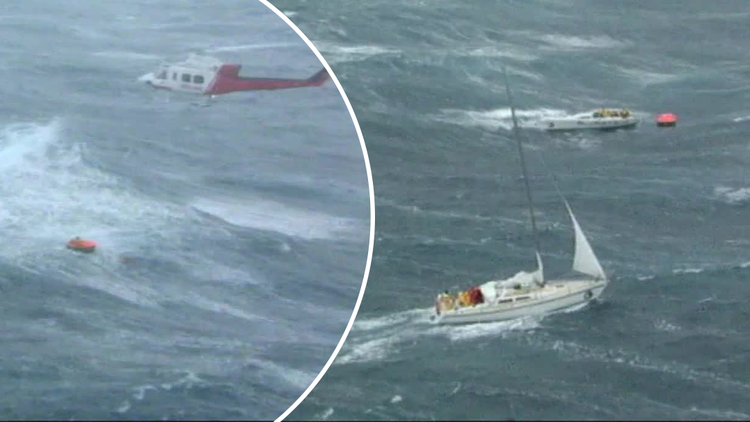
- New South Wales
Send your stories to [email protected]
Property News: They're cheap and ugly. But these houses are flying off the shelf.
Top Stories

'It'll be a gun or a needle': A suspicious death in witness protection

Subway commuters gassed to death with Nazi-era weapon

The weird and wonderful food at Sydney's Royal Easter Show


Queensland cabinet discussed backing out of Olympics this week
- Visit our Facebook page
- Visit our Instagram profile
- Visit our Twitter feed
- Visit our YouTube channel

1998 Sydney Hobart Yacht Race Remembered
Threatening skies complemented a sombre mood as skippers, crews and volunteers gathered together dockside to pay tribute to the six sailors who have lost their lives during the Sydney to Hobart ocean racing classic ten years ago. Joining them were family members of Bruce Guy, skipper of the ill-fated Tasmanian yacht Business Post Naiad, and crew member, Phillip Skeggs. Both perished during the storm that engulfed the yachts off Gabo Island in the 1998 race. Matt Allen, Commodore of the CYCA, recalled that 10 years ago a severe storm resulted in the biggest ever maritime rescue conducted in Australian waters. 25 aircraft, six vessels and approximately 1,000 search personnel braved gale force winds and dangerous seas to rescue 55 sailors. 5 yachts sank and only 44 of the 115 starters make the finish to Hobart. He paid a sincere tribute to all search and rescue personnel who continue to assist sailors when in need. Allen also remembered all those who have perished during and because of this race since 1945, and acknowledged the presence of family members of the five crew of the Tasmanian yacht Charleston which perished in Bass Strait when heading for the start of the race. “The 98 race is a poignant reminder that the sea always holds the trump card,” Allen said. “Ocean racing, like many other pursuits in life which contain a level of excitement, will always have an element of danger and risk.” Commodore of the Royal Yacht Club of Tasmania, Clive Simpson, joined Matt Allen to lower a wreath the waters of the Derwent harbour. This was followed by one minute’s silence to reflect and to remember those who had lost their lives. Family members were visibly moved by the ceremony. Mark Guy, son of Bruce, said that “I never forget my Dad and he is truly missed every day. Today’s tribute was a very special way to remember our Dad and others who lost their lives during this race. It is a lasting legacy to my father that safety changes were implemented after the race.” Ros Guy, wife of Bruce, believed the memorial service was especially important for the grandchildren. As the service concluded, Polaris of Belmont was welcomed safely to its marina berth, leaving just one yacht still racing, the Tasmanian 30 footer, Nest Property , which is due to finish during the afternoon. Father Brian Nichols recited ‘A Sailors Farewell’ We will miss you always We will remember you always We will learn from the tragic circumstances of your deaths May the everlasting voyage be blessed with calm seas and gentle breezes May you never have to reef or change a headsail at night May your bunk always be dry To us you will always be family and we wish you farewell.
CYCA Principal Sponsor
Cyca official sponsors, helly hansen, club marine, income asset management, sydney brewery, lgt crestone, the luxury collection, winnings appliances, roads and maritime services, cyca youth sailing academy sponsors and supporters, helly hansen, forecasts.global, vibe hotels, network marine, sun foundation.
Popular searches
Popular pages.
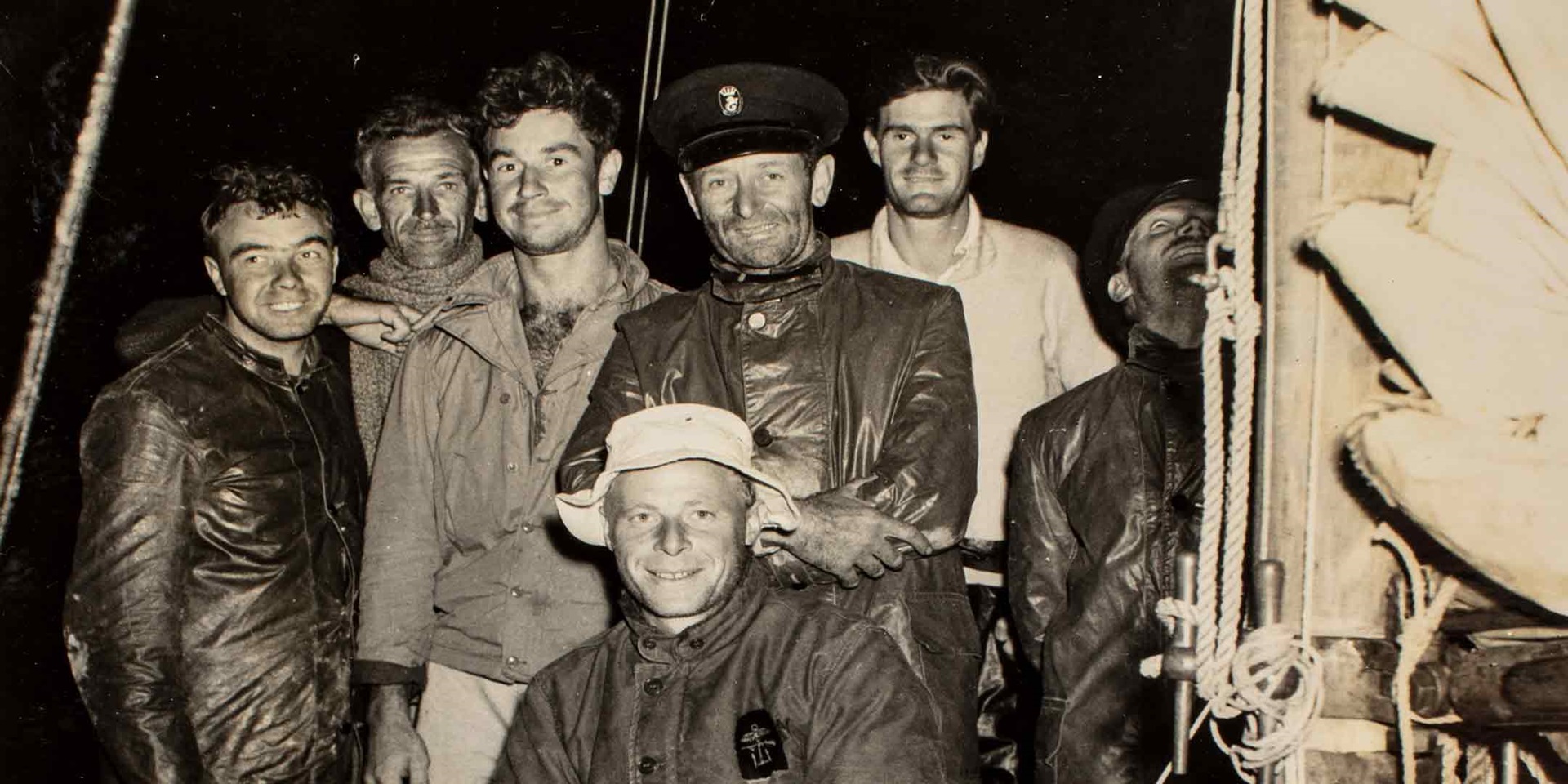
75 years of the Sydney to Hobart Yacht Race
This year marks the 75th sailing of the legendary Sydney to Hobart yacht race. After its relatively relaxed beginnings on Boxing Day 1945 – just months after the end of World War II – the race has evolved into a highlight of the ocean racing calendar. Known as one of the world’s toughest blue-water events, it attracts sailors and yachts from around the globe. For some it’s a social or sporting event, for others a fierce competitive challenge. For many, it is a bucket-list aspiration.
This year 170 boats will gather: greyhounds, bare-bones super-maxis and veteran timber cruising craft among them. It is this variety of yachts, sailors and motivations, combined with the variability of the weather and waters over the 1,160-kilometre route, which gives the race its personality – equal parts old sea dog, sprinter, sports star and supermodel.
Last year Wild Oats XI took line honours for the ninth time with the extraordinary Mark Richards at the helm, and Alive became the first Tasmanian boat in 39 years to claim the title of overall winner on handicap. The current race record was set in 2017 by LDV Comanche , at one day, 9 hours, 15 minutes and 24 seconds – an unthinkable record for those who sailed in the very first race 75 years ago.
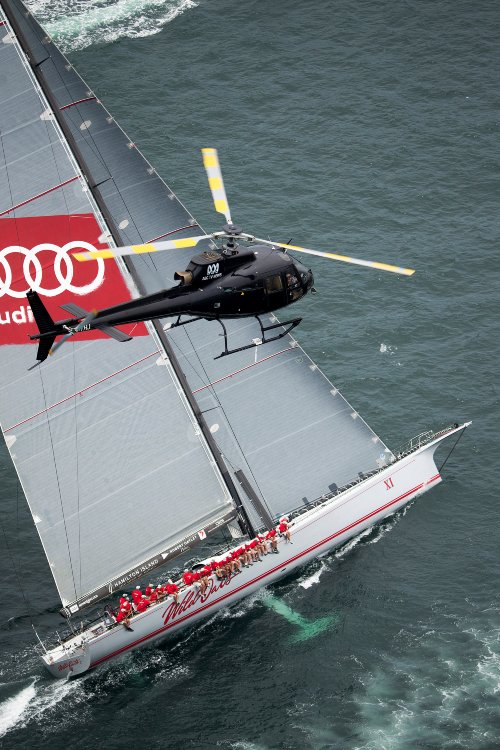
The first ‘Hobart’ sailors were friends from the newly formed Cruising Yacht Club (now the Cruising Yacht Club of Australia – CYCA), who decided on a summer cruise together to Hobart. Before they left Sydney, British yachtsman John Illingworth joined the group and proposed making it a race. The Royal Navy captain had been stationed in Sydney during the war. It was just months after the armistice and life was returning to its peace-time rhythms. The CYCA teamed up with the Royal Yacht Club of Tasmania to co-manage the race and, in the interests of keeping the focus on ‘cruising’, spinnakers were not permitted.
Nine yachts left Sydney on December 26, 1945. On 2 January 1946, Illingworth’s Rani – whose crew was mostly assembled from defence personnel – was first across the line, with a time of six days, 14 hours and 22 minutes. Peter Luke’s Wayfarer arrived after 11 days, having anchored en route at Port Arthur for roast pork and crayfish! His record stands as the slowest passage in the blue-water event.
The race grew in the post-war years, with peaks and troughs through the decades. It has seen huge social and technological change, resulting in necessary revisions of safety standards and rules. A major turning point in its history came with the deaths of six sailors in 1998, after hurricane-force winds decimated the fleet.
Challenging, Thrilling, Racing
To mark the 75th race, the museum has developed a program of exhibitions in and around its site, including the Tasman Light Gallery, Yots Café and our wharves, where you can see the iconic Kathleen Gillett , the ketch that sailed in the very first Hobart race. The Tasman Light Gallery is named for its central feature – a large, historic, first-order lens from the Tasman Island lighthouse, which all yachts in the Sydney to Hobart must pass on the final leg of the race to the finish line on the Derwent River.
Challenging, Thrilling, Racing is a dramatic visual essay about the history of the race, with a special focus on photography located in the Tasman Light Gallery. Also on display is a showcase containing the timber trophy presented to the race’s first winner, John Illingworth, as well as examples of early navigation equipment and memorabilia, a model of Wild Oats XI and a model reconstruction of a helicopter rescue of imperilled sailors in the 1998 storm. Tiger 75, the Royal Australian Navy’s 816 Squadron Sikorsky S-70B-2 Seahawk helicopter that took part in that rescue is suspended from the ceiling of the adjacent tall gallery. The helicopter has recently been transferred from the Royal Australian Navy Fleet Air Arm Museum.
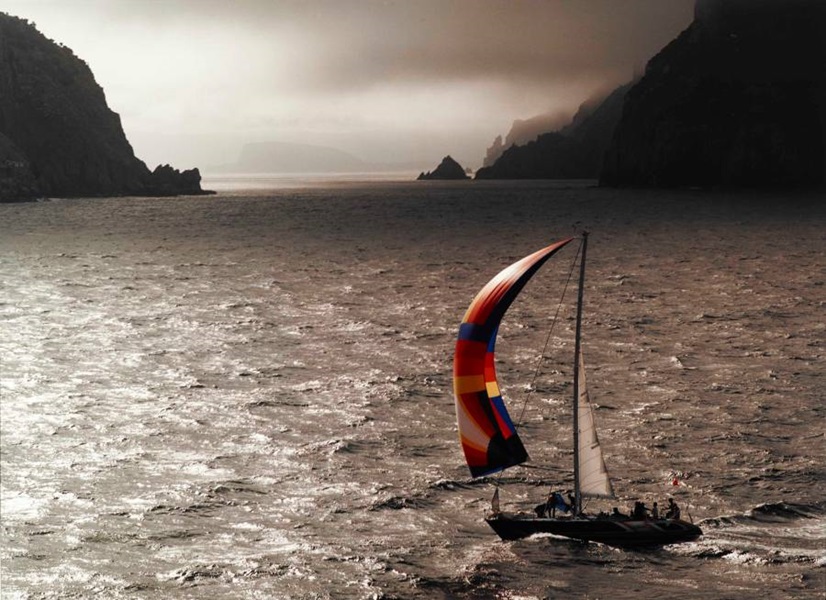
Works by Tasmanian photographer Richard Bennett are on display in the gallery, and they will also feature in the museum’s café, Yots, in the lead-up to the race. Bennett’s speciality is aerial photography, and in 1998 his aircraft was requisitioned for the search effort. His photographs of Stand Aside and Midnight Rambler fighting the huge seas have become two of the most compelling photographs from that tragic race.
Bennett, an ocean sailor himself, first photographed the Hobart race in 1974 and has captured every race since, acquiring a pilot licence to help in his search for the perfect shot. His yacht photographs are characterised by moody seas and the dramatic lines of Tasman Island landscapes. One of his personal favourites is the Shogun photograph of 1984.
I love everything about the Sydney to Hobart: the many moods of the sea, the sense of participation in a great adventure, the camaraderie, the tactics, sensing the proximity of the elements, the wildness … the gales, the different light and the dramatic coastline. It’s about putting all those elements together. There is an organisational challenge in being in the right location to capture the peak of the action. (I am not there often enough, according to the yachties!) Richard Bennett
The Tasman Light Gallery also features work by Italian photographer Carlo Borlenghi and Italian-Australian, Andrea Francolini.
Borlenghi grew up on Lake Como and developed his passion for photography while studying engineering. A non-sailor in a circle of sailing friends, he began to attend his local regatta. He travelled the world for the magazine Umo Mare Vogue , photographing the most important nautical events, and his passion grew into a career of international renown. Carlo Borlenghi is the official photographer for Rolex, the Sydney to Hobart race sponsor.
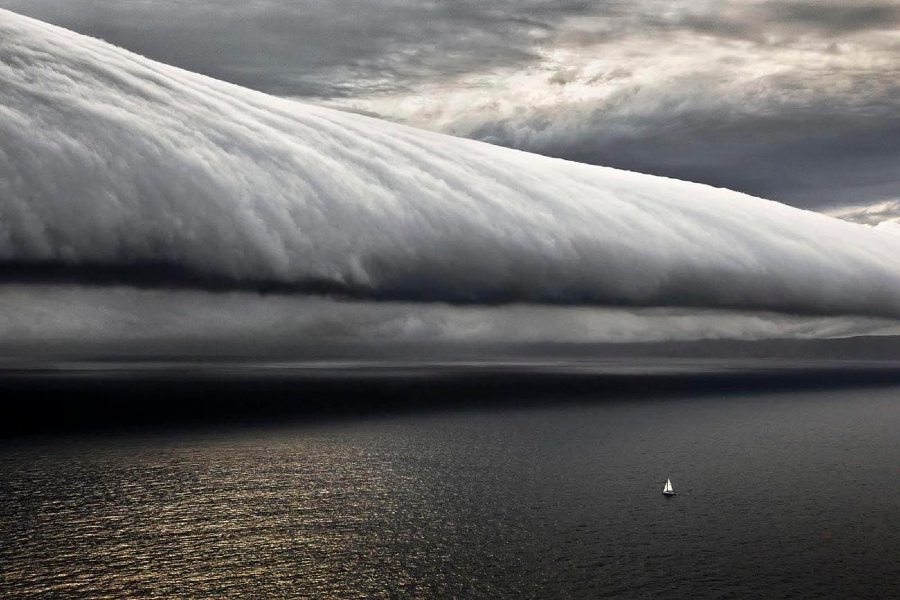
Borlenghi’s perspectives include close-framed, high-octane action on the water and panoramic aerial shots. All reveal delicate subtleties of light and tone, a Borlenghi signature, and capture an excitement of moment or mood. One of his photographic heroes is Henri Cartier Bresson, who promoted the pursuit of the ‘decisive moment’.
In all these pictures the common denominator is ‘Nature’ - the incredible light, the big sea, that you don’t find anywhere in the world. Everybody knows that my favourite race is the Rolex Sydney to Hobart Race because I like the strong sea, the big waves, the different scenery. You can find so many different things: a good background for the start in one of the most beautiful cities in the word [and later] the organ pipe and Tasman Island. Carlo Borlenghi
Andrea Francolini is another non-sailing Sydney to Hobart photographer, trained in graphic design in his native Milan. He found his vocation after a fall into the water before his first regatta left him stranded on the dock taking photographs. Francolini moved to Australia nearly 20 years ago and developed his career on the water. It remains his mainstay. Today his interests are broad and his work is informed by his admiration for reportage and portrait photographers Sebastiao Salgado, Richard Avedon and Annie Leibovitz, and Australian photographer Trent Parke.
When shooting boats, no day is the same. The boats change and, on the water, will never react the same way. A splash will always be different. As for the beaches and the ocean in Australia, the size is what really gets me, and how rough the ocean can be. The light here, too, is very different to the light in Europe or other parts of the world … You have to respect the ocean at all times. Andrea Francolini
In 2003, a portrait-sitting with sailing winemaker and businessman Bob Oatley AO BEM, led to a 14-year appointment photographing the new Oatley super-maxi Wild Oats XI – from its construction in 2005, a record of modifications, its crew and team, and above all its record-breaking run in the Rolex Sydney to Hobart Yacht Race. At the time of print, the nine-times line honours champion is undergoing urgent repairs to enable it to contest the title for the tenth time in this, the 75th race. Good luck to all 170 entrants in this year’s historic Sydney to Hobart.
Don't miss Challenging, Thrilling, Racing: Sydney to Hobart 75 Years , a dramatic visual essay about the history of this prestigious race on display now.
Main image: Skipper Captain John Illingworth (centre standing in cap) with the crew of Rani , the winner of the first Sydney to Hobart Yacht Race, 1.45 am, 2 January 1946. ANMM Collection 00048228_003 , Gift from Alison Richmond

Daina Fletcher
Daina Fletcher is a senior curator at the Australian National Maritime Museum.
S&S 34 Association
Welcome to the sparkman and stephens 34 site.

Remembering the 1998 Sydney to Hobart Race
I noted Solandra is currently listed for sale on Boatsonline.com.au.
Solandra is one of four S&S34’s that took part in the 1998 Sydney to Hobart Yacht race. This race was the 54th Sydney to Hobart and its most treacherous. Of the 115 boats which started on 26 December, 71 retired and 44 yachts completed the race.
On the second day of the race, an unusually intense low pressure depression developed which resulted in un-seasonal mid-summer snow across parts of south-eastern Australia. The weather system built into an exceptionally strong storm with winds in excess of 65 knots and gusts to 80 knots. The rising storm caused the sinking of five boats; seven were abandoned and 55 sailors had to be rescued from their yachts by ships and helicopters. Six sailors died.
Solandra was dis-masted during a knock down and retired, sailing back to Eden, N.S.W. The S&S34’s in the race were.
- T42 Solandra Craig Vescott S&S 34 1982 Retired Eden lost mast
- Misty Brian Clague S&S 34 1975 FINISHED last boat in fleet of 44
- Morning Tide A Fenwick / J Davern S&S 34 1974 RETIRED prudent seamanship
- Boomaroo Morse Fans J. McIntosh S&S 34 1971 RETIRED prudent seamanship
Misty was the only S&S34 to finish and was first in IMS division F. All these yachts are still around today.
The Coroners report report on the event contain interviews with Solandra’s skipper & crew and Misty’s skipper. They are worth a read.
http://www.equipped.org/sydney-hobart/Vol%2010%20Docs/GOODFELLOW%20David%20John.PDF
http://www.equipped.org/sydney-hobart/Vol%2010%20Docs/ESCOTT%20Craig.PDF
http://www.equipped.org/sydney-hobart/Vol%2009%20Docs/CLAGUE%20Brian%20James.PDF
VC Offshore Stand Aside (YC4882) – 1998 SHYR, 1st Mayday Photo Richard Bennett
One thought on “ Remembering the 1998 Sydney to Hobart Race ”
I bought Boomaroo from John McIntosh and he told my they were leading their division and planning to shelter behind Gabo Island when a radio schedule was due. John’s son was racing on another boat that year and there was no radio reply from them which rather shook him so they retired to Eden to await further news. His son was OK.
Leave a Reply Cancel reply
Your email address will not be published. Required fields are marked *
Save my name, email, and website in this browser for the next time I comment.
Notice: It seems you have Javascript disabled in your Browser. In order to submit a comment to this post, please write this code along with your comment: 1f99f64b9d7a4f6d25d8f22ab96713dd
- More Sports
‘Devastated’: Man overboard, more boats out of Sydney to Hobart
A total of nine vessels have been forced to retire from the Sydney to Hobart with one skipper revealing a “devastating” update.
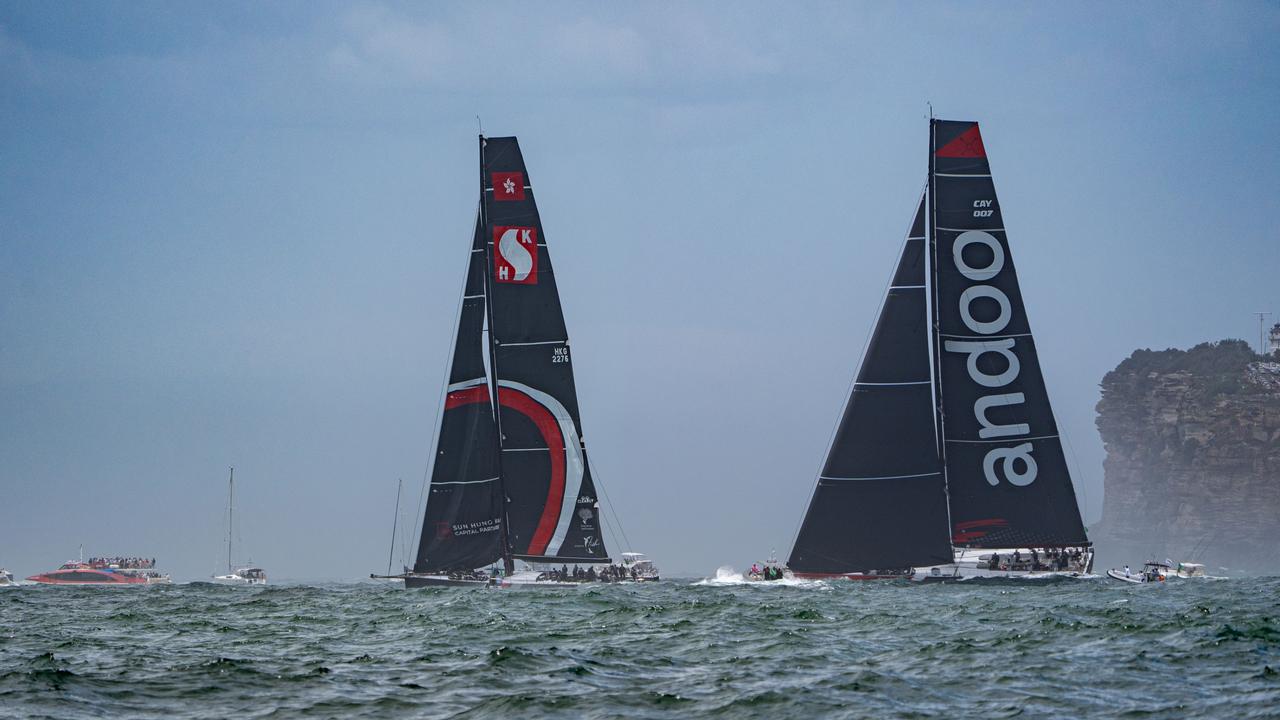
‘Liar’: Comm Games exposed as $590m farce
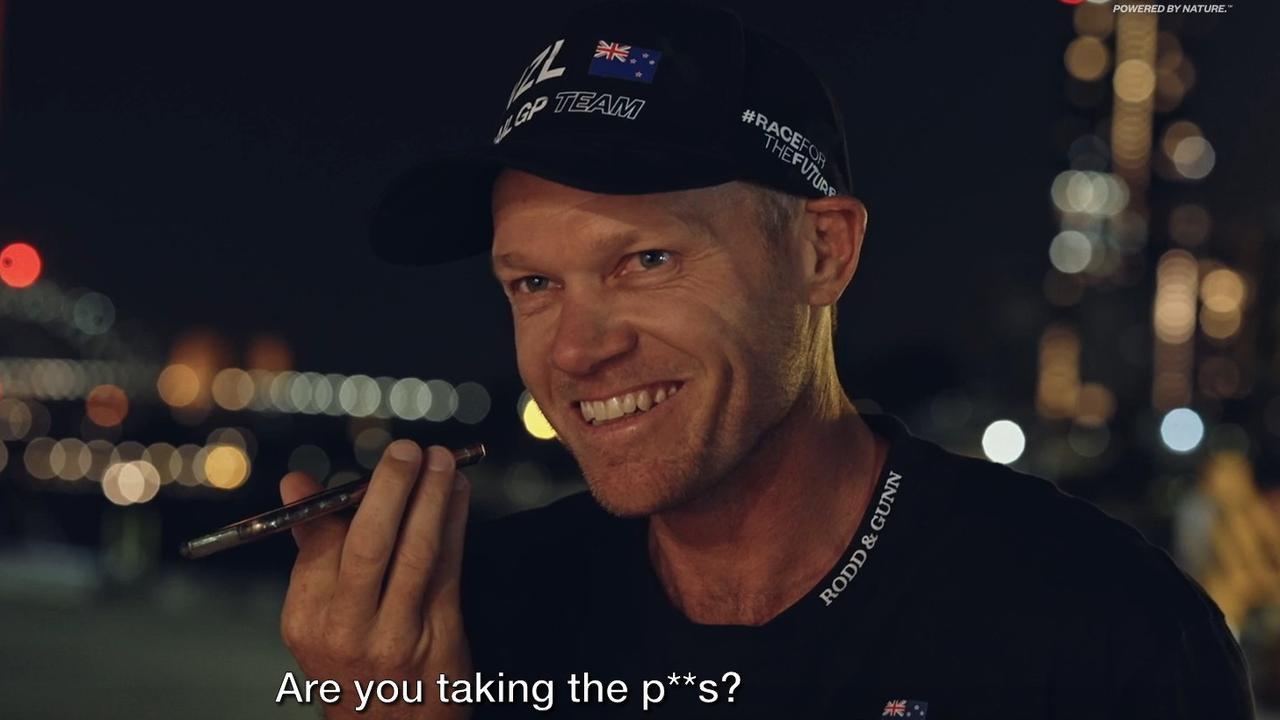
‘You taking the p***?’: Star leaves wife stunned

Karl, Campbell tear Olympics to shreds
Nine casulties have now struck the Sydney to Hobart fleet.
It was announced on Wednesday morning two more yachts had been forced to retire as the fleet made its way along the NSW south coast.
Scallywag was the first big casualty of the race after the Hong Kong-based sailing team’s bow sprit — which carries the yachts biggest sails — broke just hours into the race.
Scallywag had been the early leader and was in a fight with Andoo Comanche and LawConnect before it was forced to abandon its campaign.
Two more vessels were forced to retire in the early hours of Wednesday morning with Sticky and Maritimo 52 pulling out.
Sticky was forced to pull out with electrical damage, while Maritimo 52 had damage to rigging.
Small yacht Rum Rebellion was hit by a burst of water between Cronulla and Wollongong sending the boat on its side.
Shane Connelly was taken overboard and was a few metres from the boat but was able to swim back to it.
“We are both well and the main thing is our systems and drills all worked well,’’ he told News Corp.
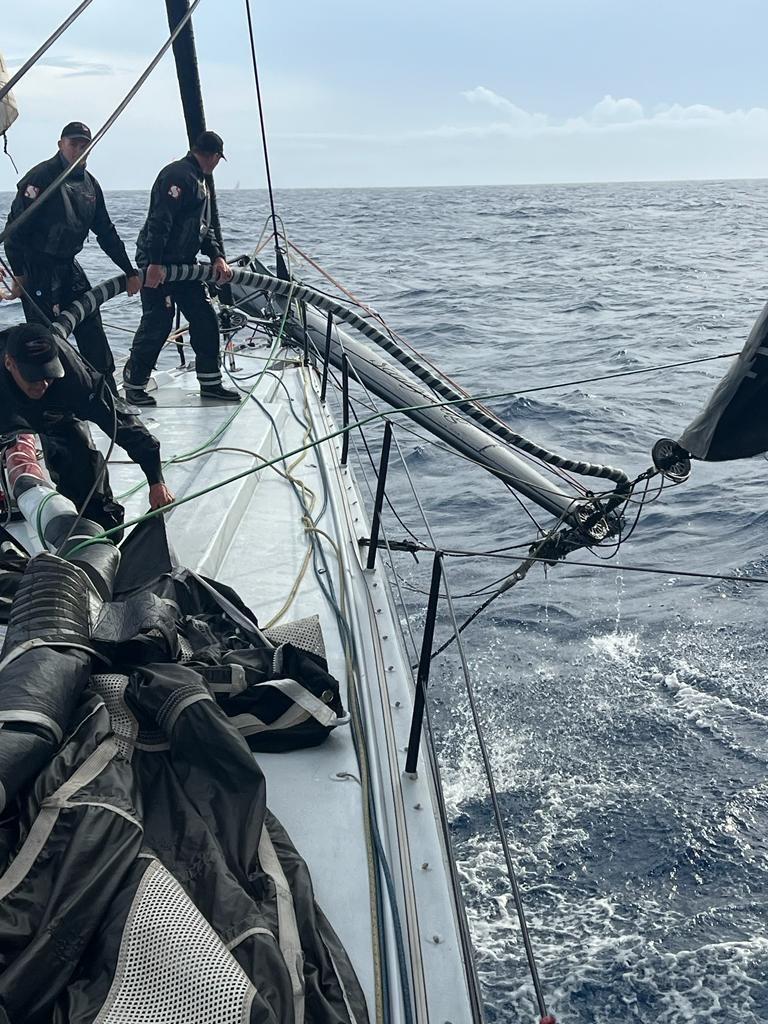
As first reported by News Corp , Arcadia on Tuesday returned to Sydney with a torn mainsail and Rum Rebellion also turned back due to an unspecified reason.
Reigning champions Andoo Comanche and LawConnect are continuing to battle for line honours as they head towards Bass Straight.
Tuesday’s retirement was a gut-punch for the Scallywag crew which had already declared the 2023 Sydney to Hobart would be its last.
News Corp reported skipper David Witt and his crew were “devastated”. The vessel has returned safely back to Sydney.
The team earlier confirmed their sad news via its social media channels.
SHK Scallywag 100 has retired from the 2023 Sydney Hobart with a broken bow sprit. The team are obviously very disappointed given the great progress we were making but thankful no one was injured & that we could safely recover. The team are making their way back to Sydney. pic.twitter.com/fuFApS3DvT — Sun Hung Kai Scallywag (@scallywaghk) December 26, 2023
The five retirements mean there are 98 entries remaining of the 103-yacht fleet that sell sail from Sydney.
Scallywag was also involved in early drama when rival Andoo Comanche flew a protest flag alleging SHK Scallywag had tacked too close as the pair exited Sydney Harbour.
Scallywag subsequently performed a 720 penalty turn to exonerate the vessel from facing a potential disqualification.
The race tracks the eastern coast of Australia southward from Sydney, crossing the Bass Strait, before continuing along the eastern coast of Tasmania and finally reaching Hobart.
Widely considered one of the most challenging yacht races in the world, teams competing in this year’s event — the 78th edition — also risk facing thunderstorms, hail and gale-force winds through the race.
The Bureau of Meteorology, whose representatives briefed the competitors ahead of the race, said there was a high degree of uncertainty for the forecasts over coming days.
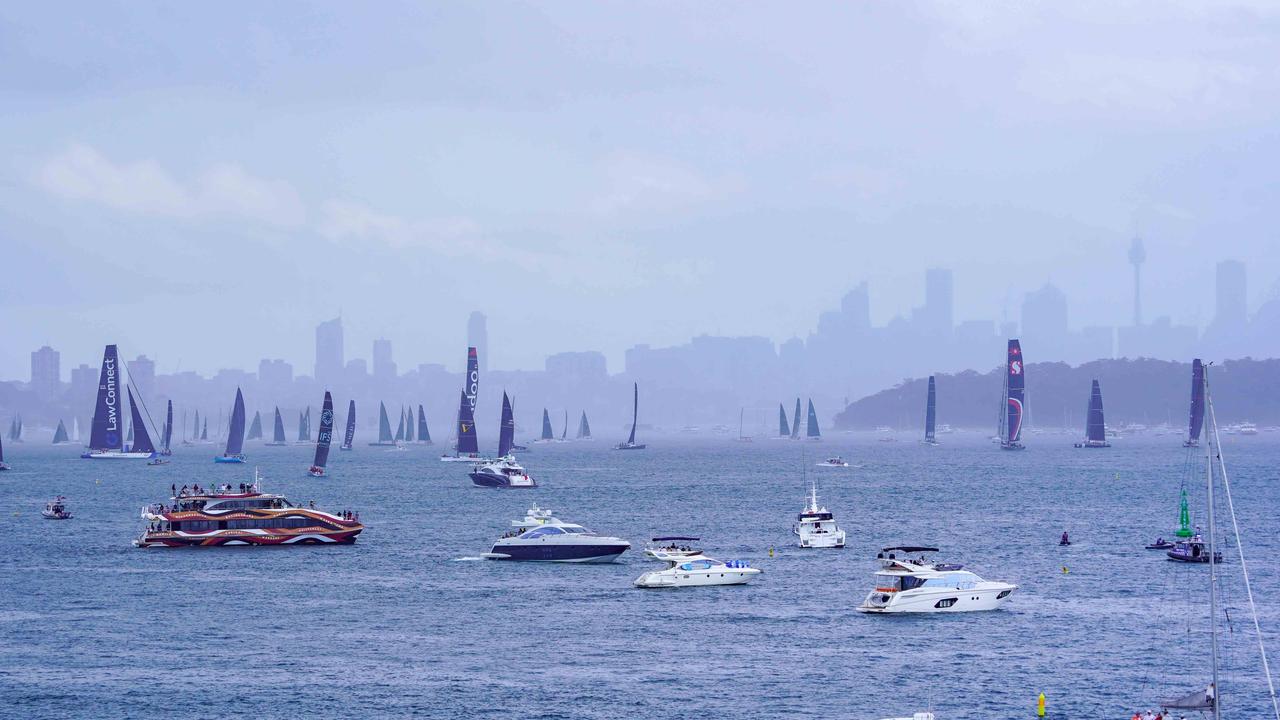
With the Bass Strait crossing often the hardest part of the race, teams can expect a larger southwest swell and strong winds.
“This year there is easterly winds and easterly swell forecast, as well as thunderstorms, which will make conditions challenging on Tuesday and Wednesday. These conditions are forecast to ease from later Wednesday,” the bureau said.
Some 113 vessels will be competing in this year’s event.
The record for the race was set in 2017 by LDV Comanche, a 100ft maxi yacht, which completed the event in just over 33 hours.
RETIREMENTS IN THE 2023 SYDNEY TO HOBART
Arcadia – Retired – mainsail damage
Currawong (TH) – Retired – electrical issues
Maritimo 52 – Retired – rigging damage
Pacman (TH) – Retired – runner damage
Rum Rebellion (TH) – Retired – minor injury
SHK Scallywag – Retired – broken bowsprit
Sticky – Retired – electrical damage
Georgia Express – rigging issues
Millennium Falcon - Retired - crew illness
Tumbleweed (TH) - Retired - crew illness
Luna Blue - Retired - damaged equipment
A damning Auditor-General report has exposed Victoria’s Commonwealth Games debacle as one of the greatest blunders in Australian sport.
An Aussie star nicknamed the “wind whisperer” has landed a new gig in the SailGP league after years of being the resident fill-in guy.
Cate Campbell has turned a flamethrower on the Queensland government with the Brisbane Olympics turning into a farce.

COMMENTS
The 1998 Sydney to Hobart Yacht Race was the 54th annual running of the "blue water classic" Sydney to Hobart Yacht Race.It was hosted by the Cruising Yacht Club of Australia based in Sydney, New South Wales.It was the most disastrous in the race's history, with the loss of six lives and five yachts. 55 sailors were rescued in the largest peacetime search and rescue effort ever seen in Australia.
Davidson is talking about the crew of the Stand Aside, one of the stricken yachts in the 1998 Sydney to Hobart ocean race. The 1998 Sydney to Hobart turned to tragedy when it was struck by a ...
Twenty years on from the 1998 edition of the Sydney to Hobart Yacht Race, Foxsports.com.au looks back at how the terrible tragedy unfolded. ... "We decided this was a life and death situation ...
Inquiry ordered - Six dead - Search ends. The start of the race, Boxing Day 1998. Simon Alekna. A fateful decision by five shipwrecked Sydney-Hobart yachtsmen to cut an air hole in the floor of ...
The horrifying drama of the 1998 Sydney to Hobart Yacht Race, in which six sailors died and five boats were lost, overshadowed the triumph of the brave crew. ... harbour city for the start of the ...
Ms Golding said that we could "absolutely" see a storm like 1998 affect the Sydney to Hobart yacht race again. ... The June storm resulted in nine deaths on the New South Wales central coast. The ...
1998 remains the most tragic year in the history of the Sydney to Hobart Yacht Race. Six sailors lost their lives, including John Dean, Mike Bannister and Jim Lawler from the Winston Churchill. Thanks to the actions of Shane and other rescue crew, 55 sailors were pulled from the tumultuous seas. Only 44 yachts finished the race, 60 having to ...
Six sailors died during the 1998 race as a result of some the worst weather conditions seen in the history of the Bluewater Classic. Hobart-based sailor John Saul was there. He skippered ...
At least five sailors have died and others are missing in the worst tragedy to hit the Sydney-to-Hobart yacht race in its 54-year history. Wind speeds reached 90 mph and towering seas turned 40 ...
The 10th anniversary of the deadly 1998 Sydney-to-Hobart race is on the horizon, and yachties, to borrow the Australian term, and a few non-yachties, may soon be reflecting, or perhaps pulling out ...
Pretty much most of the crews in the Sydney Hobart are people racing pretty much continuously.". The emphasis on safety has increased costs. "It probably costs about 60,000 Australian dollars ...
SYDNEY — It has been 20 years since tragedy hit the Sydney to Hobart yacht race, one of the toughest ocean competitions in the world. Six sailors died when a wild storm hit the fleet in 1998.
Anniversary of Sydney-Hobart Race deaths. Skip to content » ... 1998 Sydney Hobart Yacht Race Remembered. Yachting Monthly; December 31, 2008 ...
The Rolex Sydney Hobart Yacht Race is an annual event hosted by the Cruising Yacht Club of Australia, starting in Sydney, New South Wales, on Boxing Day and finishing in Hobart, Tasmania. The race distance is approximately 630 nautical miles (1,170 km). [1] The race is run in conjunction with the Royal Yacht Club of Tasmania, and is widely ...
To mark the 20th anniversary of the deadly 1998 Sydney to Hobart Yacht Race, Four Corners unearthed this archive episode investigating what happened in that ...
Speech notes obtained by 7.30 show how one man predicted the disastrous loss of life which befell the 1998 Sydney to Hobart yacht fleet, 17 years before it happened. This Boxing Day marks the 20th ...
8:38pm Dec 23, 2023. The Sydney-Hobart spectacular is back on the radar as boaties prepare to set off in the blue water classic yacht race on Boxing Day. This year's event carries extra ...
1998 Sydney Hobart Yacht Race Remembered. 29/12/2008. Threatening skies complemented a sombre mood as skippers, crews and volunteers gathered together dockside to pay tribute to the six sailors who have lost their lives during the Sydney to Hobart ocean racing classic ten years ago. Joining them were family members of Bruce Guy, skipper of the ...
Larry Ellison after the 1998 race and vowing he would never do a Sydney to Hobart again. The yacht Sayonara crashing through Bass Strait waves during 1998 Sydney to Hobart race . Picture: Channel Ten.
The current race record was set in 2017 by LDV Comanche, at one day, 9 hours, 15 minutes and 24 seconds - an unthinkable record for those who sailed in the very first race 75 years ago. Nine-times Sydney to Hobart line honours champion Wild Oats XI in 2015. Image courtesy Andrea Francolini. The first 'Hobart' sailors were friends from the ...
Solandra is one of four S&S34's that took part in the 1998 Sydney to Hobart Yacht race. This race was the 54th Sydney to Hobart and its most treacherous. Of the 115 boats which started on 26 December, 71 retired and 44 yachts completed the race. On the second day of the race, an unusually intense low pressure depression developed which ...
The record for the race was set in 2017 by LDV Comanche, a 100ft maxi yacht, which completed the event in just over 33 hours. RETIREMENTS IN THE 2023 SYDNEY TO HOBART Arcadia - Retired ...